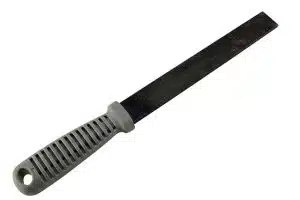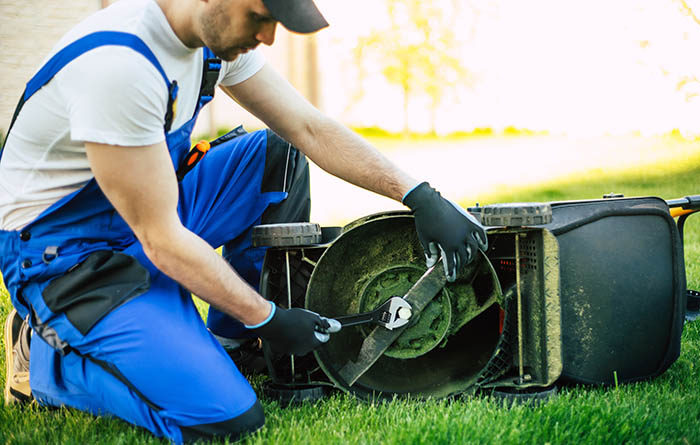Last updated on January 9th, 2025 at 04:04 pm
Sharpen Blades on lawn mower. Every year I get folks who ask me if they should sharpen blades on their lawn mower. This is what I say. ” Yes, it is important.” If the top of your grass looks brown after cutting in all probability it is caused by dull mower blades. Many maintenance landscapers just mow without ever sharpening their mower blades.
Dull blades will tear at the grass shoots making them look brown at the top and more importantly, it will take more watering to make your lawn look good again. Check out our sod and lawn tips for the southwest.
You could hire a professional to do this chore, but it will cost you. You could also do it yourself and in my opinion the better option.
If you, do it yourself, it is important to do this at least twice per year. Once in early spring and again sometime in mid-summer. In this post, we will inform you on how to sharpen them easily and quickly.
Safety Tips for You
While sharpening the blades ensure that the stroke is not too long otherwise, you may injure yourself. Always wear eye protection (goggles) and gloves when handling mower blades. Empty gas from the mower container.
The blades of a lawn mower are usually made from steel or aluminum. The steel blades are more durable and last longer, but they require more maintenance. Aluminum blades are lighter but need to be sharpened more often.
Sharpen Blades on Your Lawn Mower
What Tools Do You Need to Sharpen Mower Blades?
Depending on the size of your mower it will take about one or two hours to sharpen mower blades Unless you use a power grinder.
- A file of about 12” long
- A small crowbar or similar tool to prevent movement of the mower rotor.
- A worktable will be useful for doing the job easily.
- Good Gloves
- Safety Goggles
- Anvil
You can use the following procedure as a general rule of thumb. Make changes to suit your needs. Remember the procedure is not 100 percent accurate. The results are important, not the procedure. This procedure is for those who do not want to remove the blade(s).
1. If possible, remove the handle of the lawn mower and place the lawn mower on the table. You can also place it on the ground.
2. If possible secure it with clamps. If you do not have clamps, do not bother, secure them against any block, so that the movement away from you is restricted.
3. Fix the crowbar in the blades so that it will not rotate
4. With the help of the flat metal file, file the edges of the blades so that they look sharp. Work at a 45-degree angle.

5. When one blade is sharpened, remove the crowbar and turn the rotor to work on another blade. Repeat the procedure until all blades are sharpened.
6. The next steps are for those who will remove the blades.
7. If you have a flexible shaft grinder in your DIY workshop or garage, you will be able to complete the work within 5 to 10 minutes per blade.
Always use safety goggles and hand gloves when working with power tools. Be sure to remove the spark plug before starting. Empty the gas tank and do not empty it on the ground.
While sharpening the blades ensure that the stroke is not too long otherwise, you may injure yourself. You only need to sharpen the first two or three inches of the blade.
Sharpening Blades of a Power Mower
Depending upon the lawn mower the procedure may vary. We have included general statements in this procedure you may have to change the procedure slightly. Keep the maintenance manual of lawnmowers handy if you still have it. This procedure can also be used for the Battery Power Lawn Mower.
Tools required.
- Heavy work gloves and goggles
- Double-cut (medium-rough) flat file
- Bench vise or C clamps
- Rotary blade sharpener accessory
- Screwdriver, or 1/4-in. rod or bolt*
- Blade balancer
- Replacement blade*
- * Only if required
- The list may look formidable, but tools are generally available to every DIY enthusiast.
The procedure is given for the simple single-blade lawn mower, but the same will apply to all types of blades, whether single or double. Wear hand gloves and clean the engine and the gasoline tank from outside. Remove the spark plug from the engine.
Remove all the fuel from the tank of the gasoline engine. Use the siphon hose so you do not spill gasoline on the floor. Empty out the oil from the gearbox if you have one. Invert the engine and have access to the blade. Clamp the engine so it does not move and clean the blade area thoroughly
With help of a box spanner, remove the nut holding the blade. Usually, the nut will be unlocked in the reverse direction of the rotation of the engine. You may engage the screwdriver in the cooling fan of the engine to stop the rotation of the engine.
If you find that you are using too much force to unlock the nut, put one or two drops of rust-removing chemical, and try again after 30 minutes. WD-40 will also work.
After you remove the blade, clamp it in the bench vise and sharpen it with a file or a grinder. Sharpen only the outer 2 to 3 inches. The area to be sharpened will be known if you see the blade.
Sharpen only to the required extent. Too much sharpening is not necessary. This is not the knife. It works at the speed of the engine.
After sharpening, check your thumb! Be careful not to cut your thumb. If you have done sharpening before or seen someone doing it, you will know what I mean by this.
Balance the blade with the help of a small balancing tool on V blocks, or even on two-foot rulers placed side by side
Refit the blades, refill engine oil and gasoline, and test the sharpness of the blades on an uncut portion of your lawn.
Safety – Yes, again. Always use safety goggles and hand gloves when working with power tools. Be sure to remove the spark plug before starting. Serious accidents can happen if you do not do this.
Sharpen blades on lawn Mower

Greenhouse Manager, Master Gardener, and Webmaster.
If you have any questions or enjoyed this post, feel free to share your thoughts in the comments below.






